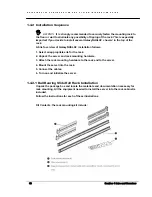
G A L A X Y N A S L X 2 C O N F I G U R A T I O N A N D S Y S T E M I N T E G R A T I O N G U I D E
16
Section 1 Intro and Overview
•
Supports up to 16 x 3.5", 1.0" SATA II half-height hard disk drives
{storage size and speeds vary depending on NAS model]
•
Sixteen hot-swappable hard disk drive bays [ number vary with NAS model]
•
Two-piece integrated backplane design that supports Serial ATA interface
•
Built-in environment controller
•
Enclosure management controller
•
Redundant power supply
•
Advanced thermal design with hot-swappable fans
•
Front panel LED Alarm and Function indicators
•
Shock and vibration proof design for high reliability
•
Dimensions 132.08mm (H) x 444.50mm (W) x 673.10mm D);
•
5.2" (H) x 17.5" (W) x 26.5" (D)
•
Weight 32.75 lbs
•
Power Supply Input Range 90Vac - 264Vac; -48Vdc Optional up to 650W
•
Ventilation 6 fans (4 front 80mm x 80mm x 25mm, 2 rear 60mm x 60mm x
25mm)
•
Environment Controller Internal Temperature - visible and audio alarm
•
Individual Cooling Fans - visible and audio alarm Ventilation 6 fans
1.3.3 Raid storage specifications
The GalaxyNASLX2 has a sophisticated built in SATA II Raid controller and drives that was
pre-configured and prepared for you so it would be plug and play for most users. By default,
the SATA RAID has been configured into 2TB RAID 6 logical volumes with the guest account
activated and one root level share named galaxynas1[unless otherwise instructed].
RAID 6 with its dual parity drive protection has been found to be the most protective and least
costly way of guarding against not only initially failed SATA disk drives but primarily against
the total loss of the RAID data because a second SATA drive detects an error during the
RAID rebuild process. A RAID 5 configuration in that scenario would cause the RAID to fail
and all data would be lost.
L
Important : the RAID controller must be setup to notify the administrator in cases
where errors occur. RAID errors are not posted to the GalaxyNASLX2. Certain RAID
controllers have an audible alarm but the most reliable way to be notified is with email.
This means that the RAID controller’s email notification needs to be setup to warn the
administrator. Follow the procedure in the attached RAID controller’s user guide for
email notification.
















































